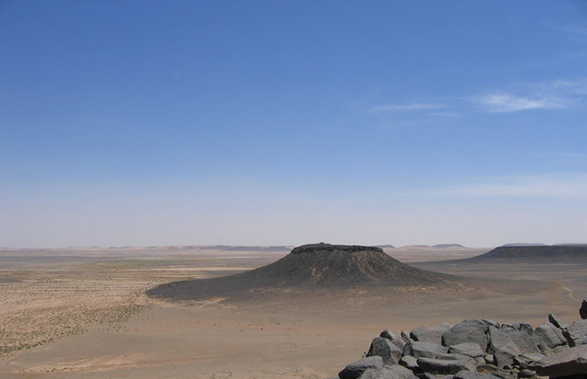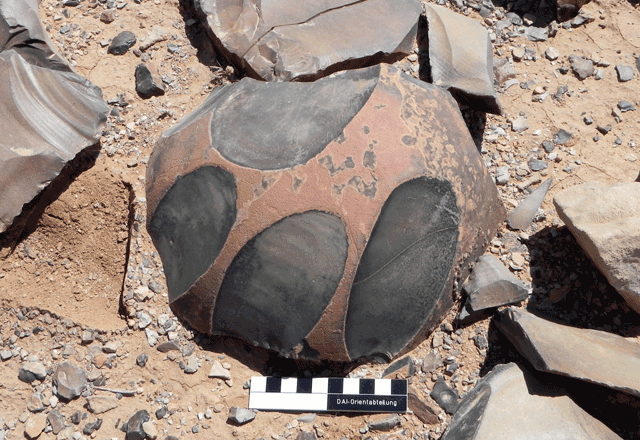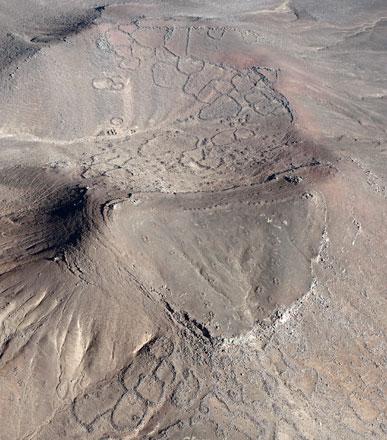You are here
Prehistoric forts in Jordan’s Black Desert challenge assumptions on early human activities
By Saeb Rawashdeh - Dec 11,2023 - Last updated at Dec 11,2023

Photo caption: A view from one hillfort in the Basalt Desert. During the Neolithic period inhabitants of the Black Desert in eastern Jordan built fortifications on the hilltops in order to monitor trade existing routes and protect their clans (Photo courtesy ACOR)
AMMAN — Archaeological research teams recently discovered several prehistoric forts on the hilltops located in the basalt desert and limestone desert of north-eastern and eastern parts of Jordan. These forts date back to the second half of the fifth millennium and the end of the forth millennium BC, and they changed a long-existing perception regarding human activities in this arid and inhospitable areas.
What is now known is that inhabitants of the Black Desert knew how to artificially irrigate their agricultural lands and they used terraced garden systems. The region is well-known for very high temperatures in summer, arid conditions and cold winds in winter.
In modern times, British pilots who flew from Baghdad to Cairo saw remains of human-made structures-desert kites and abandoned camp sites.
Subsequently, archaeological surveys and excavations provided new evidence about the human presence in the Black Desert, noted a German archaeologist Bernd Müller-Neuhof from German Archaeological Institute in Berlin.
For Müller-Neuhof, the establishment of sedentary communities and, especially, defensible hillfort sites in the Black Desert is puzzling. The better climate conditions clearly affected such settling activities and permanent occupancy. The core of the economy was based on animal keeping and pastoralism.
“The exchange and trade of animal products, as well as the exploitation and exchange of raw mineral materials from the desert with neighbouring regions were important economic pillars for the locals,” Müller-Neuhof said, adding that reasons for establishment of fortified sites remains open. It is obvious that these defensive measures reflect the existenceof hostility and violence in the Early Bronze Age societies in the Black Desert and the neighbouring regions.
“Protection against wild animals has been excluded,” the archaeologist said, adding that smaller structures were in open and they were used by shepherds who kept domesticated flock in pens and primitive barns.
“These are among the earliest fortifications in south-west Asia [at least in the Levant and Transjorda] and their original function [defence] is clearly more conceivable than the much later developed symbolic aspect of fortifications as emblems of power,” Müller-Neuhof explained, adding that the hillfort sites controlled major communication routes.
“This implies that the access to these routes had a high value, which was probably substantiated by the transport of valuable [raw] materials and/or the access to the sources of these resources via these routes. It implies furthermore the existence of competitors who sought violent solutions to reach their aims,” Müller-Neuhof underscored.
Competition and conflicts inside the Black Desert between the rival populations of the different hillfort sites appear to be a conceivable reason for the existence of these hillforts, the scholar said.
Related Articles
AMMAN — Flint tools, also called cortical scrapers, found in the Northern Badia offer clues to animal husbandry during the Early Bronze Age
AMMAN — Fortifications and the oldest known dam in the world built around 3,600BC are the main characteristics of Jawa,a site 60km nor
AMMAN — The irrigation system in the terraced gardens of the Black Desert, according to scholars, was probably the outcome of an indigenous



















